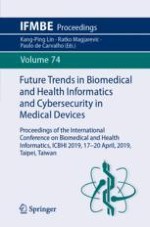2020 | Book
Future Trends in Biomedical and Health Informatics and Cybersecurity in Medical Devices
Proceedings of the International Conference on Biomedical and Health Informatics, ICBHI 2019, 17-20 April 2019, Taipei, Taiwan
Editors: Prof. Kang-Ping Lin, Prof. Ratko Magjarevic, Prof. Dr. Paulo de Carvalho
Publisher: Springer International Publishing
Book Series : IFMBE Proceedings
